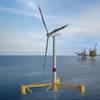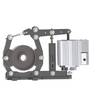Shell Shipping, Orca AI Aim to Drive Navigation Innovation
Shell Shipping & Maritime and Orca AI kicked off with a pilot project trialing Tel Aviv-based start-up Orca AI’s maritime navigation platform on a Shell-managed gas tanker. But it has now morphed into a long-term development collaboration resulting in new features that can significantly enhance safety at sea. Here Saurabh Kumar, Project Engineer at Shell Shipping & Maritime, and Dor Raviv, CTO at Orca AI, reflect on outcomes and benefits of the partnership so far.
Navigational error resulting in collision or grounding is one of the highest safety risks associated with maritime transport. Safe navigation relies strongly on Officers of the Watch (OOWs) maintaining lookout awareness and making good navigational decisions. The introduction of tools such as AIS, ARPA, VTS and ECDIS has provided more input data, but correct information processing and action response continue to rely on human factors.
As a leading charterer and ship manager, Shell has long recognized the need for new navigational tools to better support the OOW. “There has been a hiatus in novel navigational technologies since ECDIS, and serious navigation incidents are still happening. Among our many R&D initiatives we wanted to explore ways to improve situational awareness and to enhance the safety of navigation. Our aim has been to come to a deep understanding of how AI technologies can support better decision-making alongside existing systems,” explains Saurabh.
In 2019, Shell Shipping and Maritime R&D department started scanning for potential partners with technology that could be installed on oceangoing vessels. “Most autonomous ship projects focused on smaller vessels and short voyages, but we wanted something that could be scaled for larger tonnage,” Saurabh says.
Orca AI’s automated watchkeeper met Shell’s technological requirements: The solution uses a combination of thermal cameras, low-light cameras, and data from onboard sensors to create an accurate image of the waters surrounding a ship in real-time. Advanced computer vision allows the system to identify objects and classify them. The AI algorithm continuously learns the environment in order to understand hazardous situations and alert the OOW based on pre-defined thresholds.
Another deciding factor for Shell was that Orca AI’s navigation and collision avoidance system was already mature. As a ‘plug n play’ system, there is no requirement for complex retrofits.
 Saurabh Kumar, Project Engineer at Shell Shipping & Maritime
Saurabh Kumar, Project Engineer at Shell Shipping & Maritime
Getting the Green Light
Shell invited Orca AI to work on a six-month pilot that kicked off in November 2020, with the system installed on a large LNG carrier: “When we embarked on the partnership with Orca AI, we weren’t like one more customer paying a license fee. It’s much more productive to work alongside vendors to see how we can develop the product,” says Saurabh. “Our ships are like living labs in this respect. We’re using every new version on the second LNG carrier with good feedback.”
Already, in the first few months, the insights generated by the Orca AI system were significant. “The crew were expecting enhanced radar capabilities, but they soon saw that Orca AI stands on its own merits. It’s especially useful in high-traffic conditions closer to shore,” Saurabh says.
Orca AI’s Chief Technology Officer and Co-founder, Dor Raviv, says the pilot project has been key to proving the credibility and reliability of the platform. “The Shell R&D team prepared internal analysis of navigational performance using data generated by the Orca AI system, including close quarters events, from the vessel,” he explains. “The analysis clearly demonstrated the capabilities of our platform to improve safety and they are championing its value internally.”
One of the things that makes this partnership so unique, is Shell acting as a catalyst for designing new features of the Orca AI platform, such as the platform’s dashboard and monthly reports. The partnership has also matured into a testbed for the application of AI and machine learning and today Shell is supporting Orca AI in creating a more relevant product suited to any cargo segment, with a focus on actionable insights, learning and awareness
“We’re now looking at security monitoring, detecting fugitive emissions and we will shortly release a brand-new Voyage Comparison module,” Dor says. “The module is ground-breaking in that it enables users to see exactly where events occurred on a map display, including route deviations due to bad weather, alongside accompanying images and video. Secondly, users can compare different sections of a route to benchmark different KPIs across their fleet.”
The partners are also focusing on operational optimisation. Dor points out that whereas today, crews have little incentive to choose an optimised route, this will not be the case with a semi-autonomous ship. “There are many suppliers of strategic route planning systems, which are of course helpful, but no one else has a solution for tactical navigation based on high-resolution data,” he says. “Today, the Captain decides the best collision avoidance manoeuvre. However, our system can recommend a manoeuvre and optimal timing.”
Eventually the system will be integrated with the propulsion system, taking control of the helm under human supervision. This will facilitate time and distance savings that will stack up not only for individual ships but across fleets. “That could mean really large numbers,” Dor concludes. “The intention now is to develop a full-scale autonomous navigation platform that can provide real-time recommendations for collision avoidance and shore-based monitoring and take shipping operations efficiency to a whole new level.”















